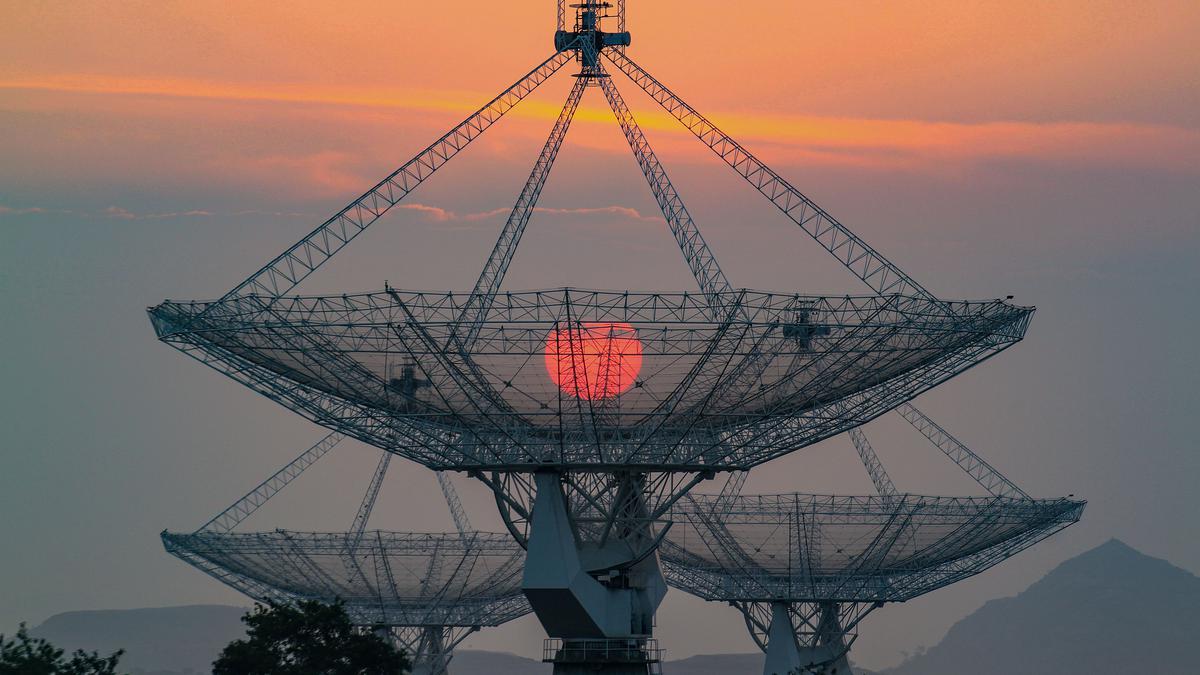
India’s largest radio telescope plays vital role in detecting universe’s vibrations
The Hindu
An international team of astronomers from India, Japan and Europe has published the results from monitoring pulsars, called ‘nature’s best clocks’, by using six of the world’s most sensitive radio telescopes, including India’s largest telescope, the Pune-based uGMRT.
India’s Giant Metrewave Radio Telescope (GMRT) was among the world’s six large telescopes that played a vital role in providing evidence confirming the presence of gravitational waves using pulsar observations, said scientists on Thursday.
An international team of astronomers from India, Japan and Europe has published the results from monitoring pulsars, called ‘nature’s best clocks’, by using six of the world’s most sensitive radio telescopes, including India’s largest telescope, the Pune-based uGMRT.
“These results provide a hint of evidence for the relentless vibrations of the fabric of the universe, caused by ultra-low frequency gravitational waves. Such waves are expected to originate from a large number of dancing monster black hole pairs, crores of times heavier than our sun,” said a statement issued by the city-based National Centre for Radio Astrophysics-Tata institute of Fundamental Research (NCRA-TIFR).
The team, consisting of members of European Pulsar Timing Array (EPTA) and Indian Pulsar Timing Array (InPTA) consortia, published their results in two papers in the Astronomy and Astrophysics journal on Thursday and shared that their results hint at the presence of such gravitational waves in their data set.
A time aberration was observed in the signals emerging from these pulsars, their studies suggest.
Pulsars are a type of rapidly rotating neutron stars that are essentially embers of dead stars which are present in our galaxy. A pulsar is like a cosmic lighthouse as it emits radio beams that flashes by the Earth regularly akin to a harbour lighthouse.
As these signals are accurately timed, there is a great interest in studying these pulsars and to unravel the mysteries of the Universe. In order to detect gravitational wave signals, scientists explore several ultra-stable pulsar clocks randomly distributed across our Milky Way galaxy and create an ‘imaginary’ galactic-scale gravitational wave detector.

SSK Matriculation Senior Secondary School witnessed a heartwarming and vibrant evening, one that tried handsomely to telescope 25 years into a few fleeting hours under a spotlight. To think one could run through 25 years in 2.5 hours or thereabouts is akin to expecting a snowflake to stay intact in a burning cauldron. But the alumni, students and the school management presented the ethos that has driven those 25 years of education. The event, which marked the culmination of the Silver Jubilee Celebrations of Sir Sivaswami Kalalaya Matriculation Senior Secondary School, chose gratefulness and allowed the various constituencies -- the school management, alumni, staff, students and parents -- to bask in the moment. It was a soiree in which students and alumni displayed their skills designed just for a stage and an audience . The highlight was a video by the alumni that stitched together individual memories and institutional achievements.

 Run 3 Space | Play Space Running Game
Run 3 Space | Play Space Running Game Traffic Jam 3D | Online Racing Game
Traffic Jam 3D | Online Racing Game Duck Hunt | Play Old Classic Game
Duck Hunt | Play Old Classic Game










